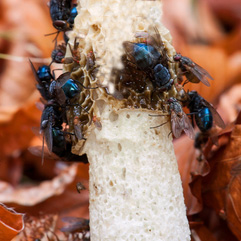Blue bottle flies

Blue bottle fly species (Calliphora vicina and Calliphora vomitoria) are large (10 mm long with a wingspan of around 25mm) flies with a characteristic blue metallic hue. Blue bottles breed and are attracted to dead and decaying animals. They are very common and associated with human activity and characterized by their loud buzzing sound.
Females can lay up to 500 eggs on decaying meat, and even fresh meat products (rendering this unsuitable for human consumption) or excrement. The white elongated eggs hatch in less than a day and liquefy heir substrate by the excretion of proteolytic enzymes. They burrow deep into their food supply. Under favourable conditions they moult 3 times in a week. Fully grown larvae migrate a considerable distance from their original food source to pupate. Pupae are considerably smaller than the maggot and are dark brown in colour. The adult fly emerges 2 weeks later.
Blue bottle flies are important in aiding the breakdown of dead animal carcasses. Their ability to seek out animal products also causes cross- contamination and the deposition of eggs on meat based products in food processing facilities. In addition these flies can become a problem if animal carcasses remain hidden (i.e. dead young birds in nesting sites, or as a result of a rodent control program).
Green bottle flies
Green bottle flies are smaller, and more variable in size than blue bottles (size: 10mm, wingspan 18 mm), but belong to the same family (blow flies). They are of the genus Lucillia and are characterized by a green metallic hue.
Larvae and pupae are indistinguishable from blue bottles. In contrast to blue bottles, green bottle flies are considered an outdoor species and reliant on warmer (spring and summer) outdoor temperatures. They are considered to be less of a nuisance compared to blue bottle flies and are even used in medicine to remove necrotic tissue from infected wounds to speed up the healing process.
However this ability to invade living tissue has also proven to be problematic in sheep were they can hatch in soiled fleeces and maggots are then able to invade surrounding tissues (myiasis). This can even result in significant mortality if left unchecked.
Control methods of blow flies
Non-residual pyrethroids can be used to quickly knock down both blue and green bottle flies. Food preparation areas (kitchens, abattoirs) often require insect screens in combination with electric fly killers. Invasion of green bottle fly larvae in sheep requires intervention by a veterinary practitioner and the use of specific medication.
